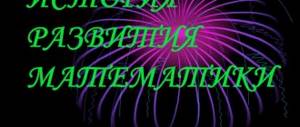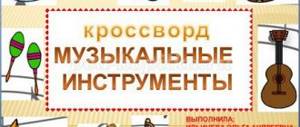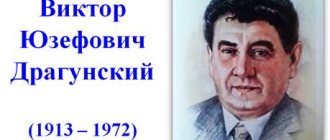Classics and modernity presentation for a music lesson (grade 7) on the topic
Slide 1
Lesson topic: Classics and modernity
Slide 2
Flash mob - (from the English flash mob - flash - flash; moment, moment; mob - crowd; translated as “instant crowd”) is a pre-planned mass action in which a large group of people (mobbers) appears in a public place, performs in advance agreed upon actions (scenario), and then diverge. The flash mob is designed for casual spectators, causing mixed feelings of misunderstanding, interest and even participation. Flash mob in Sabadell (Spain) https://ru.wikipedia.org/wiki/ Flash mob
Slide 3
Classics (from Latin with lassicus - perfect, exemplary, first-class) are those works of art that, regardless of when they were written, are the best, continue to excite many generations of people. What does the word "classic" mean?
Slide 4
He who was a good contemporary of his era has the greatest chance of being a contemporary of many future eras. A.V. Lunacharsky Anatoly Vasilyevich Lunacharsky (1875-1933) - Russian Soviet writer, public and political figure, translator, publicist, critic, art critic.
Slide 5
Sergei Prokofiev (1891-1953) Alfred Schnittke (1934-1998) Rodion Shchedrin (b. 1932)
Slide 6
No words, even the most inspired, about music can give an idea of all its inexhaustible wealth. No words can have on the soul of the listener the impact that music itself produces... To know and love music, it is not enough to read about it. We need to listen to her. D.D. Shostakovich Dmitry Dmitrievich Shostakovich (1906-1975) - Soviet composer, pianist, teacher and public figure. People's Artist of the USSR (1954), Hero of Socialist Labor (1966). Winner of five Stalin Prizes and one USSR State Prize.
Slide 7
A B C D Introduction “Dawn on the Moscow River” to the opera “Khovanshchina” by M.P. Mussorgsky Beginning of the “Egmont” overture by L. Beethoven Aria “Memory” from the musical “Cats” by E. L. Webber Fragment of “Montagues and Capulets” "from the ballet by S.S. Prokofiev Listen and match the music. fragments with musical notations:
Slide 8
1. I.-S. Bach “Prelude No. 2, C minor” 2. V.-A. Mozart “Symphony No. 40” Modern interpretations of classical works (fragments)
Slide 9
Classics of the genre Classics are works of different genres: jazz, pop, rock music. The songs of The Beatles are considered classics - examples of rock music.
Slide 10
The Beatles (individually members of the ensemble are called “Beatles”) are a British rock band from Liverpool, founded in 1960: John Lennon (rhythm guitar, lead guitar, keyboards, bass guitar, harmonica, vocals), Paul McCartney ( bass guitar, keyboards, drums, guitar, vocals), George Harrison (lead guitar, rhythm guitar, sitar, keyboards, vocals), Ringo Starr (drums, keyboards, vocals). Starting by imitating the classics of American rock and roll of the 1950s, The Beatles came to their own style and sound. They had a significant influence on rock music and are recognized by experts as one of the most successful groups of the 20th century, both creatively and commercially. “Those who are sitting in the cheap seats, clap your hands. And the rest,” (gesture towards the royal box) “just jingle your jewelry.” John Lennon at a concert at the Prince of Wales Theater https:// ru.wikipedia.org/wiki/The_Beatles Quote:
Slide 11
When I find myself in times of trouble, Mother Mary comes to me Speaking words of wisdom, let it be. And in my hour of darkness She is standing right in front of me Speaking words of wisdom, let it be. Let it be, let it be, let it be, let it be, Whisper words of wisdom, let it be. “Let It Be” John Lennon/Paul McCartney
Slide 12
Style (from the Greek stylos, literally a writing stick) means handwriting, including the author’s, a set of characteristic features, techniques, methods, and features of creativity. They distinguish: the style of the era - historical, the national style, the individual style - the style of the composer or performer. Conclusion: In order to learn to understand all the diversity of music, one must strive to understand the content of the work, its figurative structure, and whether it belongs to a certain style or artistic movement.
Summary of a music lesson on the topic “Classics and Modernity”
Summary of a music lesson on the topic “Journey through the centuries - from classics to modern times”
Volkovoy Yuri Vladimirovich music teacher
Explanation of the lesson.
The lesson examines the work of J. S. Bach “Prelude and Fugue in C major” from HTC volume I, his musical life in time “Journey through the centuries” (from classical to rap). The gradual transition of the work from the “serious” area, revealing the deep musical content of the image of the classics, to the area of “light” music with easy perception, in rap processing, is traced.
The purpose of the lesson.
- To introduce children to the heritage of world musical art.
- To form an idea of the stylistic features of the composer’s work of I.S. Bach, musical genres and styles of modern music.
Lesson objectives:
1. Educational.
- To develop skills in evaluative activities from a spiritual, moral and aesthetic position. Education of musical and aesthetic taste in students.
2. Developmental.
- To develop imaginative and creative thinking in the process of integrating fine and musical arts, critical thinking in the analysis of modern music styles.
3. Educational.
- To teach to understand and analyze musical genres and stylistic features of classical and modern musical works.
- To form in students an idea of the direction of rock music: rap
Teaching methods:
- Method of modeling the artistic and creative process;
- Retrospective method (repetition of knowledge);
- Problem situation method;
- Method of reflection and generalization of music.
Lesson type:
Deepening the topic.
Equipment.
Computer, synthesizer, music center.
Musical material:
“Prelude and Fugue in C major” by I.S.
Bach “Ave Maria” J.S., Bach - C. Gounod, 3. “Prelude” (JAY),
performance of the song “There is only a moment.”
During the classes
(There is 1 slide
presentation ).
U.
Today we continue our conversation with you about the topic “Serious” music and “light” music. I invite you on an unusual journey - “Journey through the Ages”.
We will witness the life of a wonderful work.
Please listen to the music, which of the composers you know well could have written this piece of music?
Sounds “Prelude and Fugue in C major ” by J. S. Bach
U.
So, what kind of music was played and who is the composer?
Perform a fragment of a fugue.
(Find out how the melodic line develops - the theme in the fugue. What kind of structure is it gamophonic-harmonic or polyphonic? Which of the composers of the past could create such a work?)
D.
Polyphony-polyphony. Polyphonic works of a polyphonic nature were written by J. S. Bach, a German composer who lived in the late 17th and early 18th centuries (1685-1750).
(On the screen there is 2 presentation slide, the portrait of J. S. Bach opens with a mouse click))
U.
Yes, polyphony is indeed characteristic of Bach's music. J. S. Bach is one of the greatest representatives of world humanistic culture. The work of Bach, a universal musician, is distinguished by its comprehensiveness of genres (except opera), and summarized the achievements of musical art of several centuries on the verge of Baroque and Classicism.
U
. (Performance of a fugue fragment)
The fragment heard is called Fugue, which means running.
But did the work immediately begin with a fugue?
(A fragment of the prelude is performed)
U.
It was preceded by a musical introduction, which in the time of J. S. Bach was called a prelude. To prelude meant to improvise before a singer's performance or to a fugue.
Have we heard the instrumental work by J. Bach “Prelude and Fugue in C major” from “The Well-Tempered Clavier”, a cycle written by Bach for piano that includes 24 works written in all existing keys?
U.
What musical image is revealed in this work?
(Based on character, mood, feelings.)
(Excerpts from the prelude and fugue should be played to assist in the discussion.)
D.
The foreplay is dreamy. Fugue is a reasonable, sedate story.
U.
Do you think this work belongs to which area of music can be classified as “serious” or “light”? Does music make you think?
D.
(Children should boldly express their opinions and give reasons why they think so).
U. I propose to go to the era in which J. S. Bach lived and worked.
(On the screen there is 3 slide, by clicking the mouse in the presentation slides open: musical instruments: ancient viols, violins, harpsichord; cathedrals of the Gothic architectural style)
U.
(Discuss what you saw, pay attention to the features of Gothic style architecture)
U.
But still, let's listen to the prelude again, is there a melody in the prelude (a fragment sounds), how does it develop?
D.
Iridescent movement.
U.
What if I put these shimmering sounds together (performing harmony).
D.
These are already chords - accompaniment.
U.
And since there's accompaniment, why don't we add a melody?
(A fragment from “ Ave
Maria ” by C. Gounod (vocals) is performed)
W.
This construction of the prelude made it possible for composers of subsequent centuries to turn to it and arrange it in their own performance. After all, if you remember, the music of J. S. Bach was “discovered” after his death half a century later and attracted the interest of many musicians and composers of the 19th century with its magnificence and philosophical view.
Let's listen to one of these arrangements with you. Maybe this music is familiar to you?
(Sounds “ Ave
Maria ” by J.S. Bach, C. Gounod
)
U.
Well, how familiar is the work? We have just performed several phrases of a work by the French composer C. Gounod, who turned to J. S. Bach’s prelude and based his work on it.
(On the screen there is 4 presentation slide, the portrait of Charles Gounod opens with a mouse click)
What new did the composer C. Gounod introduce to the prelude? Does the musical image of the prelude created by I. Bach remain?
D.
A musical image is an image of light, tenderness, love, an image of the Mother. The piece moved from instrumental to vocal.
U.
The work
“Ave Maria” by J. S., Bach - C. Gounod
. Is it possible to leave this work in the concept of “serious” music?
D.
The music makes you think, listen, and imagine the image of Mary.
U
.
The image of Mary, the mother of Jesus Christ, was revealed in many arts, including painting. I propose to turn now to the paintings of Raphael and A. Mantegna “Madonna”. Do you think there is something common and different between the sounding music of “Ave Maria” by J. S., Bach - C. Gounod
and the paintings.
(On screen 5 there is a presentation slide, against the background of music, paintings of Madonna open with a mouse click)
U and D:
(Discussion, expression of opinions. In music and paintings one image is revealed - the image of the Mother, but in a different language of art, in painting - with paints, in music - with musical intonations, musical means of expression).
U.
Many musical works of classical composers continue to live and sound today, at the end of the 20th and beginning of the 21st centuries. But not only the way the composer created it, but in various arrangements and remixes.
(There is a 6th slide on the screen, J. S. Bach’s “Prelude” sounds in a rap arrangement, against the background of music there are slides of buildings, buildings of the modern architectural style - constructivism, the slides change at the click of the mouse)
U.
What are your impressions of the music you heard? What new did you hear in “Prelude”?
(Pay attention to the musical features of this style)
D.
The music has acquired modern rhythms: it sounds in rap processing. She became impulsive and impetuous.
She acquired danceability thanks to the fast tempo, active rhythm, and the introduction of modern instruments: drums, synthesizers, and recitative pronunciation of words.
U.
Has the musical image created by J. S. Bach changed: the image of tenderness, dreams.
D.
Certainly. (children's statements)
U.
Is it possible to leave the “Prelude” for modern performance in the field of “serious” music?
D.
(Children should boldly express their opinions. In this presentation of the prelude, of course, the music moved into the realm of light music, because there is no desire to think, listen, but want to move)
(On screen 7 is a presentation slide with the topic of the lesson and quarter)
U.
I propose to improvise based on “Prelude” (using a synthesizer.)
Instrumental improvisation.
D.
(Give the opportunity to choose from given rhythms and timbres (already familiar to children) and improvise based on a fragment from “Prelude”. In styles: pop, rock, jazz.)
Generalization
.
U.
Today the class heard the music of a wonderful German composer
I.S. Bach not only as the composer created it, but also through the music of C. Gounod and the modern presentation of this work.
(On the screen there is slide 8 of the presentation; a mouse click opens a portrait of J. S., Bach, words by D. B. Kabalevsky)
Epilogue
:
The treasures of music are inexhaustible, and its possibilities in the future are also inexhaustible. (D. B. Kabalevsky)
U. Do you think we have the right to create such arrangements and remixes based on the music of classical composers?
After all, the musical image created by the composer (his feelings and thoughts expressed in music) changes.
D.
(Children’s statements, opinions, assumptions).
U.
I will not insist on my opinion, but I would like you to think about my question.
And at the end of our journey, after almost three centuries, and it passed in one moment, I propose to sing the song “There is only a moment.”
Performing the song “There is only a moment.”
Appendix No. 1: Multimedia presentation for the lesson.
Appendix No. 2: Music for the lesson:
1. “Prelude and Fugue in C major” by J. S. Bach
2. “Ave Maria
” I. S , Bach - Sh . Gounod
3. “Prelude” (JAY)





